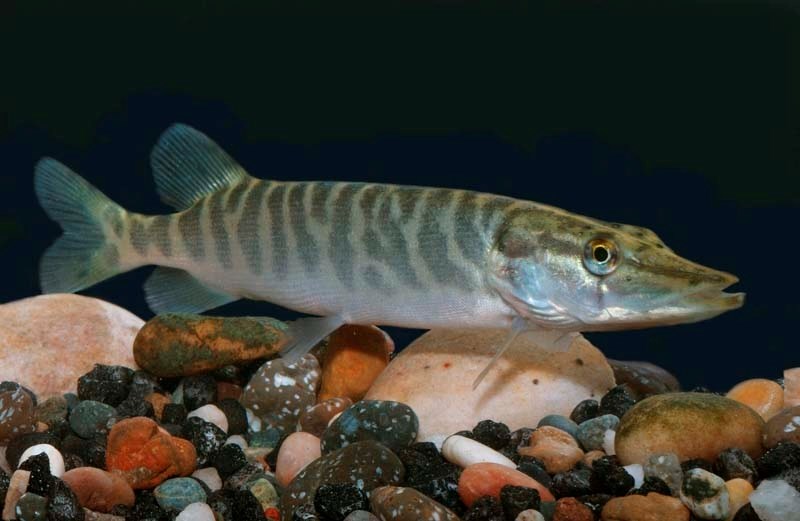A terror lurks in the depths of the Sturgeon River. It's sleek and powerful, like a shark. It lurks in the reeds, camouflaged, until some hapless creature wanders past.
A terror lurks in the depths of the Sturgeon River.
It's sleek and powerful, like a shark. It lurks in the reeds, camouflaged, until some hapless creature wanders past. Then, presumably with the theme from Jaws rumbling in its head, it surges forward and engulfs its prey with jaws full of nasty, pointy teeth.
And then … it waits. Hungry for more.
Most anglers are probably familiar with the northern pike, which is one of the biggest fish in the Sturgeon River.
But to a landlubber like me, hearing fisheries biologist Daryl Watters describe it is terrifying. "So how many teeth are we talking here?" I ask him.
"Hundreds for sure," he replies, although thousands wasn't unreasonable. (He's never counted.) "It's definitely not a place to put your fingers!"
A 40-year veteran with Alberta Fish and Wildlife, Watters is a frequent visitor to the Sturgeon and knows a thing or two about northern pike. Once derided as "slough sharks," these vicious predators have gained new favour among anglers in recent years, he says.
The northern pike is a long, sleek fish with a duck-like snout and a mouth full of big, pointy teeth, says Mark Steinhilber, curator of ichthyology (fish science) at the Royal Alberta Museum. They're very distinctive, he said, and hard to mistake for anything else around here. (You could mistake them for pickerel out east.)
Most of these pike will be greenish-brown with yellow spots, Watters says, but they can also be silver-grey or tiger-striped.
Pike are known to grow to over a metre long and can weigh up to 20 kilograms, Steinhilber says. "They can get big. Really big."
Northern pike are found throughout the northern hemisphere, Watters says, and prefer slow moving, shallow water bodies with lots of submerged vegetation – places like the Sturgeon and Big Lake, for example. If you're patient, you can stand on a bridge over the Sturgeon at this time of year and see them swimming upstream.
You'll know right away if you've got one on your line, says Randy Collins, a local angler and board member with the Alberta Conservation Association. "They are an aggressive fish," he says, and really jerk your line when they bite. "Sometimes they'll have so much strength they'll pull the rod right out of your hands."
This is probably the best time of year to see northern pike, Steinhilber says, as they'll be moving around and looking to spawn.
They'll look for open water with lots of submerged plants, Watters says, and release their eggs and sperm over them. The eggs stick to the plants and hatch up to 15 days later.
Pike spend the rest of the year floating around waiting to ambush their lunch, says Steinhilber, and can be mistaken for logs. "A lot of times you won't see them until they move."
Pike will eat seemingly anything smaller than them, including bugs, fish, ducklings, muskrats and other pike. Some meals are so big they take days to swallow, Steinhilber says.
Pike hunt by sight, Steinhilber says, using their powerful fins to dash after their victims once they lock onto them.
Here's where the teeth come in. "They're like little needles," Watters says, and the mouth is chock full of them – one row on the jaw and way too many on the roof, floor and tongue. They even have teeth on their gill covers – bad news for anyone who tries to grip them by the gills for a picture. "Your finger will pay the price."
Pike will chomp the sides of a large meal at first, Watters says, hold it until it stops struggling, and then flip it around to eat it head-first. The teeth on the gill covers helps pike hold their victims in their throats.
Pike populations are struggling in places like Lake Isle due to algal blooms, Collins notes, which sap the water of oxygen and encourage winterkill.
That can have serious consequences, Steinhilber notes, as they're often the top predators in lakes and help keep levels of other species in check. The province has brought in strict catch limits to help many northern pike populations recover.
Cottage owners can help by leaving shoreline vegetation alone for pike to spawn in, Collins says, and by limiting the amount of fertilizer they use. Anglers should pay close attention to catch limits and follow provincial fish-handling guidelines during catch-and-release. "We want to ensure that there are fish for our future."
I finally saw a northern pike at a museum recently. Knowing what I know now, I'm glad it was behind glass.
Northern pike
Name:<br />Esox lucius – a.k.a. jackfish.<br />
Appearance:<br />Long, slender fish with sharp, backwards slanting teeth, duck-like jaws and a long, flat head. Usually dark green with yellow or white spots. <br />
Commonly seen:<br />Sitting motionless in the water, waiting. Common at Lake Wabamun.<br />
Occasionally confused with:<br />Pickerel, which aren't in Alberta, or logs, which are.<br />
Fun fact:<br />Like sharks, they constantly lose and replace their teeth.
Wild St. Albert
Like wildlife? So do we! Every second Wednesday the Gazette profiles a reasonably common wild creature in the St. Albert region. Birds, beasts, bugs, fish … so long as it's alive and kicking, we'll feature it. <br /><br />Got a creature you'd like to see profiled? Send your suggestions to [email protected].




